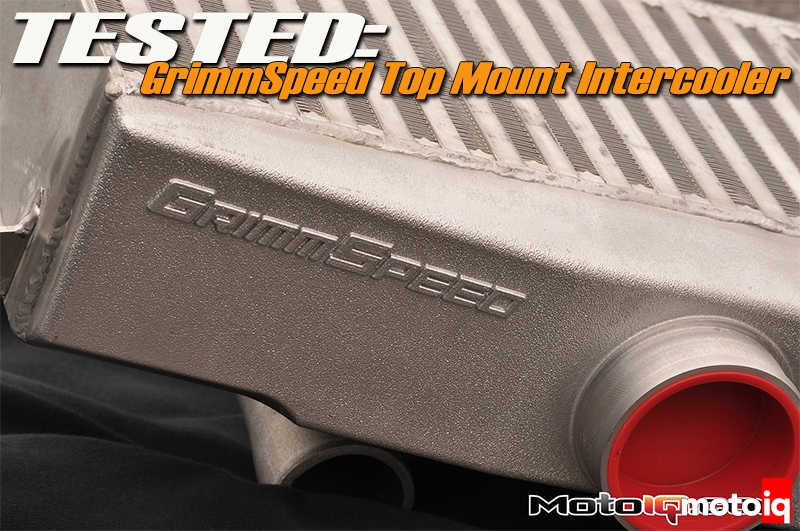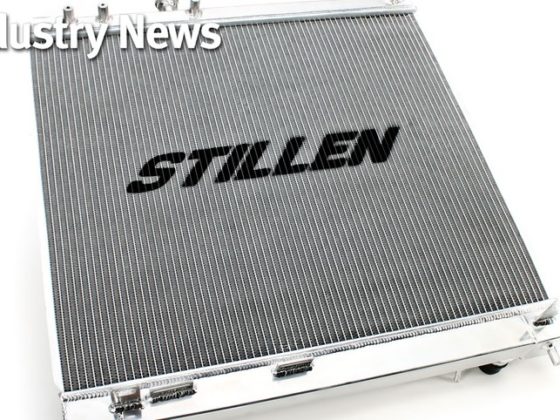,
 GrimmSpeed also offers this optional splitter to replace the OEM unit. It features larger diverters that help to more evenly distribute flow over the intercooler core.
GrimmSpeed also offers this optional splitter to replace the OEM unit. It features larger diverters that help to more evenly distribute flow over the intercooler core. We did a test run install to make sure everything fit as it should as well as to replace the OEM hard lines that mount to the OEM intercooler; these fittings vent the cylinder heads back to the intake. GrimmSpeed provides the necessary hose and quality T-fitting to re-route these hoses as with the larger IC using the OEM hard lines is not an option. Also included with the intercooler kit are silicone couplers and associated T-bolt clamps. The ONLY snag we faced during the install was that the provided BPV recirculation hose was too short for the 2004 STi that was our project. This really wasn’t a snag as we were able to re-use the OEM hose without issue. We also opted to use the factory worm drive clamps on a few of the connections, namely the IC to throttle body as well as the turbo outlet as they were simply easier to tighten within the tight confines of those locations. With a little experience behind our belt we were able to swap back and forth within about 15 minutes tops and that involved consuming the cold beverage of our choice; If you must know it was either a Sun Drop or a cold beer!
With the preliminary install sorted and the OEM TMIC put back in the car we turned our eyes to taking data on the OEM intercooler to gather a baseline as well as to learn the ropes of our data acquisition device. If you recall, resident supernerd Khiem Dinh did a great article on testing intercooler efficiency using a 4 port thermocouple datalogger and we used this exact device to put the OEM and GrimmSpeed units through their respective paces.
The unit is the Omega RDXL4SD and it can log up to 4 temps. at once. This is perfect for IC testing as we use the 4 ports to log Ambient, Turbo intake/inlet, Turbo Outlet, and Post intercooler. In the case of the top mount intercooler on the EJ motor the turbo outlet is essentially the pre-intercooler probe as there is very little piping between the turbo and the intercooler inlet. We took the time to familiarize ourselves with this tool by doing some general data logging on the OEM TMIC to make sure we had a handle on readings as well as having the unit functioning properly when we were strapped to the dyno.
The goal was to get the car on a dyno. to be able to optimize the current tune as well as to be able to test the two intercoolers back to back to show efficiency #’s between the two, not necessarily peak dyno power over each other. Intercooler testing can be complex and simply looking at peak dyno. #’s does not tell you the entire story on if a larger intercooler is of benefit within your setup. How the car is used, boost level, supporting mods. as well as fuel choice all play a role and in the case of our test car a larger TMIC would be a consumer’s next logical choice as every other power component had been addressed. The other ideal here is that if the car’s owner chose to go to a larger OEM fitment turbo every supporting modification would be addressed to make that switch possible.
 The Omega RDXL4SD is a VERY handy device to have around. It can log up to 4 ports of thermocouple data at a time and records to a standard SD card.
The Omega RDXL4SD is a VERY handy device to have around. It can log up to 4 ports of thermocouple data at a time and records to a standard SD card. Our initial datalogging lasted over several days and events from street driving to drag racing to get an idea of how efficient the OEM intercooler was before heading to the dyno. We also wanted to be able to compare efficiency on the street during normal driving versus all out dyno testing. The reality is that with a properly sealed and ducted scoop during flat out driving on a road course with fresh air constantly being fed to the TMIC we knew that we would see maximum efficiency #’s versus what we saw on the dyno. with the car stationary and the hood up. We wanted to observe what the real world monitoring showed us. GrimmSpeed themselves had done quite a bit of testing of their TMIC and frankly we wanted to see if our results were similar. Everyone knows that if a company tests something and posts results they are clearly lying in an attempt to sell more product, or at least that is what every accredited skeptical internet scrutineer would have you believe. In this case we would be able to tell if GrimmSpeed was “fluffing” us or giving us the goods and we certainly hoped for the latter or we would never hear the end of the tirades from the aforementioned know-it-alls.

We arrived at the rollers to get the car strapped down with the OEM intercooler in place. Our tuner was Brian Leazenby and the shop was Six Star Motorsports based out of Schaumburg Illinois. When I first heard of Brian he was referred to as “Gangster” and the visions of his appearance formed in my head. When we finally met I almost laughed out loud as clearly he and I fell out of the same tree that produces the nerdiest looking white people in North America. Brian and the boys from Six Star got the STi strapped down and reviewed the cars current tune and after some tweaking we were able to do some pulls to log data and calculate efficiency. We did 4 pulls and we averaged the temps. for the timed duration of the dyno. pulls. We extracted data from the cells that accounted for the time spent at positive manifold pressure and ended when throttle was released. For cooling we had fans on both the front and rear of the car as well as a blower placed directly on the high side of the intercooler (which happens to be the hottest area as the air enters the top most end tank). We also made notes of the 4 temp. readings just as we went in to our first test so that we could try and recreate these conditions for the testing of the GrimmSpeed unit.



